CAHDD™ (Computer Aided Human Designed & Developed) is building initiatives that bring transparency and trust into creative and technical work. CAHDD™ is a philosophy and framework to bring clarity to creative work. The rating system, icons, and watermark tools are just ways to express that idea — not the idea itself.” From the CAHD™ rating system and watermark standards to awareness campaigns and educational resources, every effort is aimed at keeping human creativity at the center while embracing the benefits of technology. Whether in architecture, visual arts, design, music, or engineering, the mission is the same: preserve human expression while responsibly integrating new tools.
CAHDD™ is flexible by design. You can participate by simply declaring your stages on your website, using text labels, creating your own icons, or using our free watermark set. Visible markings on the work itself are optional — the important thing is that the stage is clear somewhere. As technology evolves, invisible watermarks and embedded metadata will work alongside or even replace visible marks.
Ways to declare your stage:
• Text labels (e.g., “Stage 2 – Algorithmic Assistance”) on your site or gallery
• Your own custom icons or badges
• CAHDD™ watermark icons on the work itself
• Invisible watermarking or embedded metadata (C2PA, IPTC)
Maintaining Evidence of Process
A key part of this approach is encouraging creators to maintain evidence of their process. Work-in-progress files, drafts, project documentation, and backups are more than just good practice—they serve as proof of authorship and ownership. By recording the steps behind your work, you strengthen your copyright and intellectual property claims while also giving the CAHD™ rating system more context and credibility. Transparency begins with creators themselves, and simple habits like documenting process ensure that authorship is never in doubt.
The CAHD™ Rating System
The CAHD™ system is voluntary, adaptable, and designed to spark trust. It uses two complementary elements:
- CAHD Watermark
- A subtle dot-pattern overlay, placed in colors that complement the work representing the chosen stage (CAHD-0 through CAHD-X).
- Applied directly to creative output, showing where the creator believes the project belongs on the CAHD™ scale.
- Unobtrusive but transparent — visible if you look for it, yet not distracting from the art itself.
- CAHD Icon
- A clear, standalone graphic representing the chosen stage (CAHD-0 through CAHD-X).
- Not applied to the artwork itself.
- Used where visibility matters: portfolios, websites, online stores, or contest entries.
When people first encounter CAHDD™, their eyes are often drawn to the icons and watermarks. That’s understandable—they’re the most visible expression of the system. But the real heart of CAHDD is not the graphics. It’s the stage framework itself: a simple, honest way to communicate how much of a creative work was shaped by human hands versus automated or AI tools.
The icons and watermarks we provide are just free tools to make that communication easier. They’re not mandatory, and they’re not branding. In fact, creators and organizations are encouraged to adapt the system to fit their own workflows and aesthetics. Some may simply state on their website that they support the CAHDD framework and that their work never exceeds Stage 3. Others may prefer to include a discreet “Stage 3” text mark in a footer, while some will proudly use the official CAHDD icons on every piece. All of these approaches support the same core idea: transparency.
We also recognize that not everyone wants visible marks on their work. As technology evolves, invisible watermarking and embedded metadata (such as C2PA) will allow creators to carry their stage declarations inside the file itself. That fits perfectly within the CAHDD philosophy. But for audiences and clients, having some form of visible indicator—whether a watermark, a footer note, or a gallery label—remains an important part of honest communication.
CAHDD™ operates on an honor system. The stages are self-declared, and the icons or indicators themselves are not legal proof. If a client, partner, or court requests verification, it’s the responsibility of the creator or organization to provide supporting material—for example, work-in-progress files, prompt logs, timestamps, layered source files, or other documentation of their process.
This supporting information doesn’t just back up a stage declaration—it’s also a critical safeguard for intellectual property rights. In copyright disputes, clear evidence of human creative contribution can determine whether a work qualifies for protection. Retaining structured proof of your workflow helps demonstrate authorship, clarify where and how AI tools were used, and protect ownership claims. For clients, this transparency builds trust. For creators, it provides legal resilience in a rapidly evolving landscape where questions of authorship and originality are increasingly complex.
“CAHDD™ isn’t just about transparency—it’s about protecting your creative legacy.”
CAHDD™ is not a governing body. We don’t enforce compliance or dictate how anyone creates. Our goal is to build a shared language and culture of transparency so audiences, clients, and creators can make informed choices as technology evolves. The stage system is the keystone, while the indicators are flexible. Start where you’re comfortable, grow as the tools evolve, and always keep honesty at the center.
Not Enforcement — Encouragement
CAHD™ is a framework for honesty, not a policing system. Creators are encouraged — but not required — to support their chosen stage with WIPs, drafts, or process videos. CAHDD™/CAHD™ may host contests or public directories. If proof of process is required, CAHDD™ may issue a Statement of Effort & Transparency to acknowledge creators who provide documentation supporting their declared stage. This statement does not constitute certification or independent verification. Your stage declaration is an expression of your process. If proof is requested — by clients, contests, or legal settings — it’s up to the creator to supply supporting evidence (WIPs, logs, metadata, drafts). The icons alone are not a certificate or guarantee.
At Its Core
The CAHD™ Rating System is about honesty and trust. By combining unobtrusive watermarks, visible icons, and simple process documentation, creators can show their integrity while helping clients and audiences understand how work was made.
CAHD™ Stages
The stages below show the spectrum of creative work — from fully human-made, to supported by software and automation, to AI-assisted and AI-driven.
CAHD™ Rating System – TechRatio
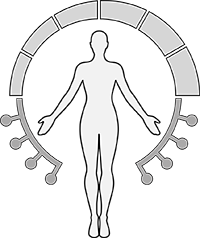
Icon Level 0

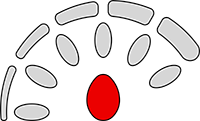
Watermark Level 0
Stage 0: Traditional Human Craft
Visual/Design: Entirely handmade with physical media — painting, drawing, sculpture, model-making, drafting, photography with film, etc. No digital tools, no automation, and no AI are involved. This represents the purest point on the TechRatio™, reflecting complete human authorship.
Music: Pure acoustic performance and recording. No digital editing, no AI, no automation. Acoustic music reflects the lowest end of the Software–Human Ratio™, relying entirely on human skill.
Summary: 100% human expression through physical or analog methods only. This stage establishes the baseline of the Human–Tech Balance Index™.
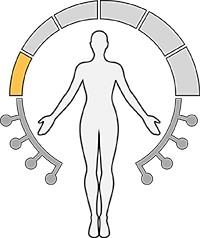
Icon Level 1
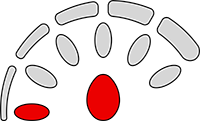

Watermark Level 1
Stage 1: Digitally Assisted Creation
Visual/Design: Created using digital tools such as Photoshop, CAD, Illustrator, or digital sculpting software, but with all creative direction and execution performed by humans. There is no algorithmic generation or AI involvement — the software functions strictly as a tool.
Music: Human compositions and performances that are edited, mixed, or mastered using digital software, without automated composition or AI generation. Examples include manual EQ, reverb, timing adjustments, or multitrack mixing.
Summary: Human creativity leads entirely, with digital tools extending capability but not altering authorship. This stage remains near the human-dominant end of the TechRatio™ and Software–Human Ratio™ scales.
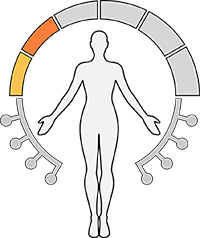
Icon Level 2
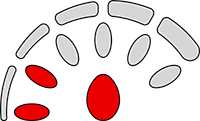

Watermark Level 2
Stage 2: Algorithmic Assistance
Visual/Design: Involves algorithmic or procedural tools—such as scripts, filters, physics simulations, parametric modeling, or photogrammetry—under human control. No derivative AI is used; automation occurs only at a task level, not in content creation.
Music: Uses intelligent effects, adaptive mastering, auto-mixers, or algorithmic tools under human supervision, but does not generate new musical content. The human remains the composer and performer.
Summary: Human direction remains central while algorithmic tools provide structured assistance. This stage represents a mid-range TechRatio™, where technology supports execution but not ideation or content generation.
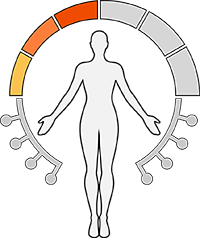
Icon Level 3
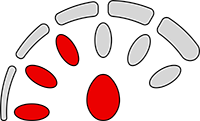

Watermark Level 3
Stage 3: Human–AI Hybrid Creation
Visual/Design: The human and AI collaborate in a balanced, structured workflow. This may involve the human providing a concept, sketch, or simple 3D model, which the AI then renders or enhances into a more detailed image, or the reverse—the AI generates a derived base image which the human directs, edits, and refines into the final result. Either way, the human maintains clear creative direction, defining the vision, structure, and key decisions, while the AI acts as a productivity amplifier. This stage reflects a middle ground on the TechRatio™, where human and machine contributions are distinct yet complementary.
Music: A hybrid approach combining human composition, performance, or arrangement with AI-derived instrumentation, effects, or structure. For example, a human may lay down core melodies and rhythms, and an AI system expands or reorchestrates them — or vice versa, with the human shaping raw AI output into a structured piece. This represents a balanced Software–Human Ratio™, where neither side fully dominates the creative process.
Summary: Stage 3 sits at the center of the Human–Tech Balance Index™, representing the most common and practical hybrid workflows today. It allows creators to leverage AI as a powerful extension of their capabilities without surrendering authorship. Whether the human or the AI initiates the creative process, direction and intent remain firmly in human hands.
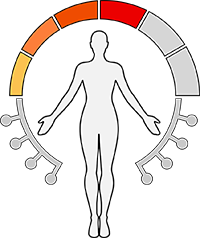
Icon Level 4


Watermark Level 4
Stage 4: AI-Generated, Human-Curated
Visual/Design: The majority of content is derived by AI systems. The human role focuses on prompting, selecting outputs, and making limited edits or adjustments. Creative control shifts toward the system.
Music: AI generates most of the arrangement or composition. The human acts primarily as curator, mixer, or light editor, making final refinements rather than directing core content.
Summary: The TechRatio™ and Software–Human Ratio™ lean heavily toward machine authorship, with the human serving as curator or overseer. Transparency becomes critical at this stage for honest disclosure.
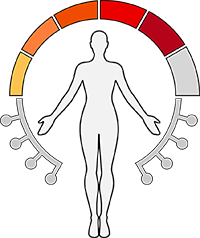
Icon Level 5


Watermark Level 5
Stage 5: Fully Autonomous AI Creation
Visual/Design: The work is produced entirely by AI with little or no meaningful human creative input beyond initial configuration or triggering. This represents the AI-dominant extreme of the TechRatio™.
Music: The AI autonomously composes, arranges, and produces the work, with no human involvement in performance, composition, or editing.
Summary: A fully machine-originated stage. The human acts as spectator or reviewer rather than creator. On the Human–Tech Balance Index™, this represents complete technological authorship.
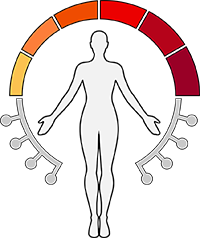
Icon Level X
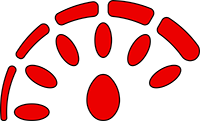

Watermark Level X
Stage X: Hybrid / Multi-Phase Workflows
Visual/Design: Applies to multi-stage or experimental pipelines that span several CAHDD stages or involve real-time human–AI interplay. Examples include a project starting at Stage 2 for modeling, moving through Stage 4 for AI rendering, then receiving extensive Stage 3 post-production — or live, iterative human–AI improvisation. Stage X is flexible by design, acknowledging emerging tools, iterative back-and-forth processes, and future technologies that don’t fit neatly into a single stage.
Music: Improvised or layered collaborations where humans and AI interact dynamically — such as live co-performance, real-time AI accompaniment, or multi-pass workflows involving composition, generation, and human restructuring.
Summary: Stage X recognizes that some workflows combine multiple distinct phases or unfold through simultaneous human–AI improvisation. It’s not simply a reversed or hybrid Stage 3 — it’s for complex, multi-modal pipelines that reflect the evolving frontier of creative collaboration.
There are Many Disciplines and Professions that are Applicable:
The CAHDD™ TechRatio™ philosophy was created to bring transparency and trust to all forms of human creativity and innovation. Its principles apply far beyond art and design—to engineering, architecture, music, medicine, education, research, product development, writing, entertainment, and countless other disciplines. Many of these professions already feel the influence of technology and automation, while others will encounter it in ways not yet fully understood. The goal of CAHDD™ is to provide a shared language for expressing how humans and technology collaborate across every creative and technical domain, allowing each field to clearly communicate the balance of human authorship and technological assistance in its work.
The CAHDD™ framework recognizes that technology has become inseparable from creation and problem-solving. Architects use parametric design tools that explore forms once impossible to draw by hand. Engineers run automated simulations that help them refine complex systems. Musicians compose through hybrid digital setups that merge human performance with algorithmic harmony. Writers and educators rely on digital tools to analyze, summarize, and teach with greater clarity. Even in medicine, AI is helping visualize anatomy, simulate surgeries, and interpret data at scales no human could manage alone. Across all of these professions, CAHDD™ provides a way to express the degree of human versus technological contribution without judgment—simply as a transparent measure of process.
The CAHDD™ TechRatio™ framework applies to every field where humans and technology intersect. Below are domain-specific interpretations showing how the same seven stages (0–X) manifest across creative and technical professions—from art and architecture to music, film, education, and beyond. These examples evolve as tools and workflows change, and we welcome community input to refine and expand them over time.
Index of Professions:
• Visual Arts & Illustration
• Architecture & Design
• Music & Audio Production
• Writing & Literature
• Film, Animation & Game Design
• Education & Research
• Engineering & Technical Design
• Product & Fashion Design
• Medical & Scientific Visualization
• Marketing, Media & Communication
• Crafts, Makers & Artisans
• Performing Arts (Acting, Dance, Stage)
Visual Arts & Illustration
Stage 0 – Traditional media only. Hand-drawn, painted, or sculpted work without any digital or automated tools.
Stage 1 – Fully digital artwork under human control using standard design software.
Stage 2 – Use of scripts, filters, or automation plugins while maintaining full creative direction.
Stage 3 – AI or software suggestions for composition, color, or lighting used under human guidance.
Stage 4 – AI or generative systems produce large portions of the image, refined and composited by the artist.
Stage 5 – AI creates nearly the entire image or sequence, artist curates or performs post-production adjustments.
Stage X – Fully autonomous image generation without meaningful human direction.
Architecture & Design
Stage 0 – Hand sketches or physical models produced entirely by humans.
Stage 1 – CAD or 3D modeling software used manually without automation.
Stage 2 – Parametric or scripted modeling under human direction.
Stage 3 – AI or algorithmic tools assisting with layout, optimization, or material study.
Stage 4 – Generative design producing structures or concepts, refined and approved by the designer.
Stage 5 – AI produces full building forms or site plans with minimal human revision.
Stage X – Automated design output with no direct human authorship or oversight.
Music & Audio Production
Stage 0 – Acoustic or analog performance recorded without automation.
Stage 1 – Digital recording and editing tools used by the musician.
Stage 2 – Plugin-based or scripted automation under human control.
Stage 3 – AI-assisted composition, arrangement, or mastering suggestions refined by the artist.
Stage 4 – AI generates full musical sections that the musician edits or overlays.
Stage 5 – AI creates entire compositions; human provides quality control or curation.
Stage X – Fully automated generative music with no human input.
Writing & Literature
Stage 0 – Handwritten or manually typed work without digital assistance.
Stage 1 – Digital writing tools used only for convenience and formatting.
Stage 2 – Grammar and style automation, still fully human-directed.
Stage 3 – AI suggestion tools assist with phrasing or summarization under editorial control.
Stage 4 – AI generates large sections of content, human edits and polishes.
Stage 5 – AI authors most text, human curates or approves.
Stage X – Fully autonomous generative writing without meaningful human authorship.
Film, Animation & Game Design
Stage 0 – Traditional hand-drawn animation, live-action film, or analog processes.
Stage 1 – Digital production pipelines fully human-driven.
Stage 2 – Automated rendering, motion capture, or rigging controlled by artists.
Stage 3 – AI assists with lighting, compositing, or motion interpolation.
Stage 4 – AI generates scenes or sequences refined by editors.
Stage 5 – AI builds full productions or levels, humans finalize.
Stage X – Fully autonomous generation of visual media.
Education & Research
Stage 0 – Human-taught instruction, fully analog delivery.
Stage 1 – Digital presentation tools used manually.
Stage 2 – Automated grading, formatting, or slide generation under human control.
Stage 3 – AI-assisted tutoring or research summarization guided by educators.
Stage 4 – AI develops lesson materials, educators curate and contextualize.
Stage 5 – AI handles majority of instruction or analysis; human oversight remains.
Stage X – Autonomous knowledge delivery or data interpretation with no human involvement.
Engineering & Technical Design
Stage 0 – Manual drafting, physical prototyping.
Stage 1 – CAD or simulation tools operated directly by engineers.
Stage 2 – Automated calculation, simulation, or optimization scripts.
Stage 3 – AI proposes design optimizations, materials, or tolerances under review.
Stage 4 – Generative design creates prototypes refined by humans.
Stage 5 – AI designs full systems; engineers validate output.
Stage X – Fully autonomous engineering design with no human input.
Product & Fashion Design
Stage 0 – Manual sketching or hand tailoring.
Stage 1 – Digital design software operated by human designer.
Stage 2 – Pattern automation, digital prototyping, or parametric scaling.
Stage 3 – AI generates colorways, patterns, or silhouettes for refinement.
Stage 4 – AI develops full designs reviewed and modified by human.
Stage 5 – AI drives the majority of creative process; human acts as brand curator.
Stage X – Fully AI-generated product or collection.
Medical & Scientific Visualization
Stage 0 – Hand-drawn diagrams or traditional illustration.
Stage 1 – Digital modeling and visualization by human specialists.
Stage 2 – Automated rendering, measurement, or simulation under supervision.
Stage 3 – AI aids in segmentation, reconstruction, or annotation.
Stage 4 – AI generates full models or visualizations refined by specialists.
Stage 5 – AI generates and labels full datasets; human validation only.
Stage X – Fully autonomous simulation or visualization.
Marketing, Media & Communication
Stage 0 – Hand-crafted or analog campaigns.
Stage 1 – Digital marketing or layout software operated manually.
Stage 2 – Automation for formatting, scheduling, or analytics under control.
Stage 3 – AI suggestions for targeting, headlines, or visual layout.
Stage 4 – AI generates majority of assets, humans select and refine.
Stage 5 – AI executes entire campaign, human supervises output.
Stage X – Fully autonomous marketing or content delivery.
Crafts, Makers & Artisans
Stage 0 – Fully handmade craftsmanship.
Stage 1 – Use of power tools or digital measuring aids.
Stage 2 – CNC or laser cutting under human control.
Stage 3 – AI-aided design planning or material layout suggestions.
Stage 4 – Automated fabrication from AI-generated plans refined by maker.
Stage 5 – Robotic fabrication with minimal human setup.
Stage X – Fully autonomous fabrication or production.
Performing Arts (Acting, Dance, Stage)
Stage 0 – Fully live, human performance.
Stage 1 – Digital lighting, sound, or camera systems under human control.
Stage 2 – Choreography or direction using motion capture or automation.
Stage 3 – AI-generated lighting cues, choreography suggestions, or virtual scene assists.
Stage 4 – Virtual actors or AI avatars guided by human performers or directors.
Stage 5 – AI controls performance, voice, or movement with human supervision.
Stage X – Fully synthetic performance or digital actor autonomy.
Closing Paragraph:
The CAHDD™ TechRatio™ framework is designed to evolve with technology and community participation. Each domain adapts these stages to reflect its own creative and technical realities. The framework is flexible, open, and continuously evolving. We recognize that no single organization can define every nuance of creative and technical work, which is why the CAHDD™ initiative invites participation from practitioners, educators, researchers, and industry professionals alike. Real-world experience and honest insight are essential for keeping this system relevant and truthful. We encourage professionals across all fields to contribute refinements, share examples, and help ensure that the CAHDD™ TechRatio™ remains transparent, accurate, and human-centered as the world continues to innovate.
Flexible and Unobtrusive
CAHD™ icons and watermarks are designed to be versatile indicators, never distractions. Icons are ideal for use in contexts like online stores, literature, or product pages, while watermarks provide a subtle but visible signal of stage/TechRatio directly on imagery.
Watermarks can be rendered in any color or combination that complements the artwork or brand logo without clashing or distracting. As a general guideline, they should be sized at approximately 2% of the image width (for example, a 1200-pixel-wide image would use a watermark about 24 pixels wide). Opacity may be reduced as long as watermark is Legible. Placement should ensure visibility but never overwhelm the work itself.

Watermarks may also be integrated into an artist’s or studio’s logo, giving precedence to the creator’s branding on all their work. The CAHD™ stage indicator is meant to support transparency, not impose external branding. Our proposal is an indicator system — not a replacement for identity, Watermark designed to be as flexible as possible to integrate with end users standards.
In practice, the artwork or content always comes first. Phases and indicators matter, but they must remain in service of the creative work, not the other way around. For this reason, watermarks should harmonize with the visual context or logo they accompany.
We welcome suggestions and examples from others on evolving graphic indicators or new approaches to the “TechRatio.” This system is intentionally open to refinement by the community.
All icons and watermarks are the intellectual property of CAHD™ and parent company 3DAllusions LLC. They may be used freely to indicate a CAHD™ stage, but may not be redistributed under false claims of authorship, nor sold as standalone assets. Their use is permitted within creative works, projects, or commercial materials solely as a stage/TechRatio indicator. Any use beyond this scope requires explicit permission.Licensing
CAHD™ Icons & Watermarks License
Version 1.3 — October 2025
© 2025 3DAllusions LLC™. All rights reserved.
0. DISCLAIMER
The CAHD™ and CAHDD™ systems provide a voluntary framework for transparent disclosure of the human–technology creative balance. Use of CAHD™ icons, watermarks, or stage indicators does not constitute certification, verification, or legal proof of authorship. Responsibility for the accuracy of declared stages rests solely with the creator or entity applying the indicators. Neither CAHDD™, CAHD™, nor 3DAllusions LLC™ verify or guarantee claims made through the use of these marks.
1. PURPOSE
The CAHD™ icons and watermarks are provided as transparent indicators of creative process stages (the “TechRatio™”). They exist to help artists, studios, musicians, designers, and creators disclose the role of human effort versus technological or automated assistance in their work. These icons are visual shorthand for communicating stage classifications to audiences, clients, and collaborators. They are not required to participate in the CAHDD™ philosophy — they are offered as free, standardized tools for those who wish to visually signal their TechRatio™.
2. PERMITTED USE
- You may freely use the icons and watermarks in your own creative works, media, or commercial materials to indicate CAHD™ stages.
- You may resize the icons/watermarks proportionally and recolor them to harmonize with the artwork, content, or logo they accompany. Recoloring does not create a new design; the underlying icon remains the property of CAHDD™ and 3DAllusions LLC™.
- You may integrate watermarks into your company or studio logo, provided the CAHD™ mark remains intact and recognizable.
- You may redistribute the icons/watermarks only in their original form, as part of the official CAHD™ package with this license included.
- You may create your own visual indicators to represent CAHDD™ stages, provided they do not copy or imitate the official icons in a way that may cause confusion. Community sharing of alternative indicators is encouraged, as long as proper attribution and stage alignment are maintained.
3. RESTRICTIONS
- You may not distort, redraw, rebrand, or alter the core shape, proportions, or design of the icons/watermarks.
- You may not claim authorship of the icons/watermarks.
- You may not sell, license, or distribute the icons/watermarks as standalone products or as part of another asset package.
- Use of the icons/watermarks may not imply endorsement by CAHD™, CAHDD™, 3DAllusions LLC™, or its affiliates.
- You may not use the icons or watermarks to knowingly misrepresent the creative process, TechRatio™, or stage classification of any work.
4. COMMERCIAL CONTEXT
- The icons/watermarks may be used within commercial works (art, music, design, products) solely to indicate CAHD™ stages or TechRatio™.
- Proceeds from works in which the icons/watermarks are embedded are permitted.
- No separate commercial rights to the icons/watermarks themselves are granted.
5. ATTRIBUTION
Where practical, we encourage noting:
“CAHD™ Stage Indicator by 3DAllusions LLC™ — https://CAHDD.org”
Attribution is preferred but not mandatory when watermarking images directly.
6. TRADEMARK & OWNERSHIP
- CAHD™, CAHDD™, TechRatio™, 3DAllusions LLC™, 3DAStudio™, MrMaterials™, and XtremeGraphxs™ are trademarks of 3DAllusions LLC™.
- Use of the icons/watermarks does not transfer ownership of these marks.
- Pairing or superimposing icons/watermarks into logos or artworks does not negate 3DAllusions LLC™’s ownership of the icons/watermarks.
- The creative works to which these icons/watermarks are applied remain the sole property of their creators.
7. FEEDBACK & COMMUNITY INPUT
This system is intended to evolve. Suggestions and examples of alternate indicators are welcome and may influence future versions.
8. TERMINATION
Any use that violates these terms may terminate your rights under this license.
9. PROOF & RECORDKEEPING
The CAHDD™ framework operates on an honor system. Creators are strongly encouraged to retain working files, WIP images, or other supporting materials that demonstrate their declared stage classification. While CAHD™ icons and watermarks are not proof themselves, such documentation may support claims in the event of client disputes, platform takedowns, or copyright challenges.
Note: As provenance, metadata, and watermarking technologies evolve (e.g., C2PA, invisible watermarks), CAHDD™ indicators may also take the form of embedded or machine-readable signals. The principles of stage disclosure remain the same regardless of format.
For inquiries, custom permissions, or partnership opportunities:
info@CAHDD.org


